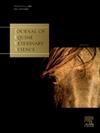虚拟现实种马收集模拟对学生唾液皮质醇水平的影响
IF 1.6
3区 农林科学
Q2 VETERINARY SCIENCES
引用次数: 0
摘要
处理和收集种马需要在马的行为和管理能力方面的专业知识。再加上没有经验的大学生参加了马术课程,可能会导致潜在的危险情况。提供动手学习的机会是必不可少的,结合虚拟现实(VR)模拟可以增强学生的准备,减少学生和动物的风险。本研究通过唾液皮质醇浓度(SCC)测量了VR种马收集模拟对学生压力水平的影响,在动手收集种马之前和之后,随后评估了学生对VR训练的看法。我们假设VR参与者在收集种马后SCC较低。参加马生产和管理课程的大学生,之前没有处理种马的经验,被随机分配到对照组(n = 27)或VR组(n = 30)。在进入繁殖设施前20分钟和亲自采集种马后20分钟,通过SalivaBio口腔拭子采集唾液样本。VR组的参与者在动手活动之前进行了20分钟的VR种马收集模拟。使用Salimetrics (Carlsbad, CA)分析皮质醇浓度,并使用具有最小显著差异的一般线性模型(SPSS)评估数据。采集前SCC组间差异无统计学意义(0.226±0.019µg/dL; = 0.657页);然而,与对照组(0.271±0.028µg/dL)相比,VR组采集后SCC(0.180±0.026µg/dL)较低; = 0.019页)。一项活动后调查显示,VR组90%的学生觉得VR体验很愉快,而10%的学生报告有轻微的晕动病。在处理或收集种马的信心方面,学生表示信心完全没有增加(0%)、很少增加(6.67%)、有些增加(56.67%)或很大程度上增加(36.67%)。这些发现表明,VR模拟减少了学生在动手收集种马时的压力,同时增加了他们的准备和信心,有可能使他们更专注,更安全地参与动手活动。本文章由计算机程序翻译,如有差异,请以英文原文为准。
Influence of virtual reality stallion collection simulation on student salivary cortisol levels
Stallion handling and collection require expertise in horse behavior and the ability to manage horses. This, coupled with inexperienced collegiate students enrolled in equine courses, can lead to potentially precarious situations. Providing hands-on learning opportunities is essential, and incorporating virtual reality (VR) simulations may enhance student preparedness, reducing risks to both students and animals. This study investigated the impact of a VR stallion collection simulation on student stress levels, measured through salivary cortisol concentration (SCC), before and after hands-on stallion collection, with subsequent assessment of student perceptions of the VR training. We hypothesized that VR participants would have lower SCC post stallion collection. Collegiate students enrolled in an equine production and management course, with no prior stallion handling experience, were randomly assigned to either the control (n = 27) or VR group (n = 30). Saliva samples were collected via SalivaBio oral swab 20 min before entering the breeding facility and 20 min after hands-on stallion collection. Participants in the VR group engaged in a 20-min VR stallion collection simulation immediately before the hands-on activity. Cortisol concentrations were analyzed by Salimetrics (Carlsbad, CA), and data were evaluated using a general linear model with least significant differences (SPSS). Pre-collection SCC did not differ between groups (0.226 ± 0.019 µg/dL; P = 0.657); however, post-collection SCC was lower in the VR group (0.180 ± 0.026 µg/dL) compared with control (0.271 ± 0.028 µg/dL; P = 0.019). A post-activity survey revealed 90% of students in the VR group found the VR experience enjoyable, whereas 10% reported slight motion sickness. Regarding confidence in handling or collecting a stallion, students indicated that confidence was increased not at all (0%), very little (6.67%), somewhat (56.67%), or to a great extent (36.67%). These findings suggest that the VR simulation reduced student stress during hands-on stallion collection while increasing perceived preparedness and confidence, potentially enabling greater focus and safer participation in hands-on activities.
求助全文
通过发布文献求助,成功后即可免费获取论文全文。
去求助
来源期刊

Journal of Equine Veterinary Science
农林科学-兽医学
CiteScore
2.70
自引率
7.70%
发文量
249
审稿时长
77 days
期刊介绍:
Journal of Equine Veterinary Science (JEVS) is an international publication designed for the practicing equine veterinarian, equine researcher, and other equine health care specialist. Published monthly, each issue of JEVS includes original research, reviews, case reports, short communications, and clinical techniques from leaders in the equine veterinary field, covering such topics as laminitis, reproduction, infectious disease, parasitology, behavior, podology, internal medicine, surgery and nutrition.
 求助内容:
求助内容: 应助结果提醒方式:
应助结果提醒方式:


